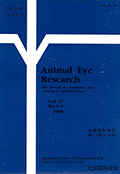Volume 17, Issue 3-4
Displaying 1-7 of 7 articles from this issue
- |<
- <
- 1
- >
- >|
Reviews
-
1998Volume 17Issue 3-4 Pages 3-4_87-3-4_96
Published: 1998
Released on J-STAGE: December 25, 2020
Download PDF (5765K) -
1998Volume 17Issue 3-4 Pages 3-4_97-3-4_103
Published: 1998
Released on J-STAGE: December 25, 2020
Download PDF (3661K)
Original Reports
-
1998Volume 17Issue 3-4 Pages 3-4_105-3-4_109
Published: 1998
Released on J-STAGE: December 25, 2020
Download PDF (2342K) -
1998Volume 17Issue 3-4 Pages 3-4_111-3-4_118
Published: 1998
Released on J-STAGE: December 25, 2020
Download PDF (3224K) -
1998Volume 17Issue 3-4 Pages 3-4_119-3-4_123
Published: 1998
Released on J-STAGE: December 25, 2020
Download PDF (2015K)
Original Brief Notes
-
1998Volume 17Issue 3-4 Pages 3-4_125-3-4_129
Published: 1998
Released on J-STAGE: December 25, 2020
Download PDF (1930K) -
1998Volume 17Issue 3-4 Pages 3-4_131-3-4_133
Published: 1998
Released on J-STAGE: December 25, 2020
Download PDF (1001K)
- |<
- <
- 1
- >
- >|
